Altered distribution of interstitial cells and innervation in the rat urinary bladder following spinal cord injury
- PMID: 21883887
- PMCID: PMC3823221
- DOI: 10.1111/j.1582-4934.2011.01410.x
Altered distribution of interstitial cells and innervation in the rat urinary bladder following spinal cord injury
Abstract
Changes in the distribution of interstitial cells (IC) are reportedly associated with dysfunctional bladder. This study investigated whether spinal cord injury (SCI) resulted in changes to IC subpopulations (vimentin-positive with the ultrastructural profile of IC), smooth muscle and nerves within the bladder wall and correlated cellular remodelling with functional properties. Bladders from SCI (T8/9 transection) and sham-operated rats 5 weeks post-injury were used for ex vivo pressure-volume experiments or processed for morphological analysis with transmission electron microscopy (TEM) and light/confocal microscopy. Pressure-volume relationships revealed low-pressure, hypercompliance in SCI bladders indicative of decompensation. Extensive networks of vimentin-positive IC were typical in sham lamina propria and detrusor but were markedly reduced post-SCI; semi-quantitative analysis showed significant reduction. Nerves labelled with anti-neurofilament and anti-vAChT were notably decreased post-SCI. TEM revealed lamina propria IC and detrusor IC which formed close synaptic-like contacts with vesicle-containing nerve varicosities in shams. Lamina propria and detrusor IC were ultrastructurally damaged post-SCI with retracted/lost cell processes and were adjacent to areas of cellular debris and neuronal degradation. Smooth muscle hypertrophy was common to SCI tissues. In conclusion, IC populations in bladder wall were decreased 5 weeks post-SCI, accompanied with reduced innervation, smooth muscle hypertrophy and increased compliance. These novel findings indicate that bladder wall remodelling post-SCI affects the integrity of interactions between smooth muscle, nerves and IC, with compromised IC populations. Correlation between IC reduction and a hypercompliant phenotype suggests that disruption to bladder IC contribute to pathophysiological processes underpinning the dysfunctional SCI bladder.
© 2011 The Authors Journal of Cellular and Molecular Medicine © 2011 Foundation for Cellular and Molecular Medicine/Blackwell Publishing Ltd.
Figures
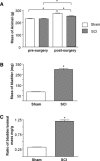

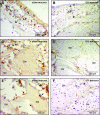
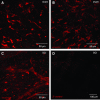
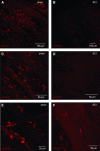
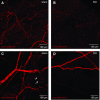
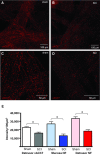
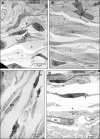
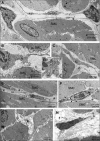
Similar articles
-
Morphological expression of KIT positive interstitial cells of Cajal in human bladder.J Urol. 2010 Jul;184(1):370-7. doi: 10.1016/j.juro.2010.03.005. Epub 2010 May 20. J Urol. 2010. PMID: 20488490 Free PMC article.
-
The effects of Glivec on the urinary bladder excitation of rats with suprasacral or sacral spinal cord transection.J Surg Res. 2013 Aug;183(2):598-605. doi: 10.1016/j.jss.2013.02.030. Epub 2013 Mar 13. J Surg Res. 2013. PMID: 23608618
-
Identification of different phenotypes of interstitial cells in the upper and deep lamina propria of the human bladder dome.J Urol. 2014 Nov;192(5):1555-63. doi: 10.1016/j.juro.2014.05.096. Epub 2014 Jun 2. J Urol. 2014. PMID: 24893312
-
Do we understand any more about bladder interstitial cells?-ICI-RS 2013.Neurourol Urodyn. 2014 Jun;33(5):573-6. doi: 10.1002/nau.22591. Epub 2014 May 16. Neurourol Urodyn. 2014. PMID: 24838179 Free PMC article. Review.
-
Bladder interstitial cells: an updated review of current knowledge.Acta Physiol (Oxf). 2013 Jan;207(1):7-15. doi: 10.1111/apha.12009. Epub 2012 Oct 17. Acta Physiol (Oxf). 2013. PMID: 23034074 Review.
Cited by
-
Transient receptor potential vanilloid type 4 (TRPV4) in urinary bladder structure and function.Curr Top Membr. 2022;89:95-138. doi: 10.1016/bs.ctm.2022.06.002. Epub 2022 Jul 18. Curr Top Membr. 2022. PMID: 36210154 Free PMC article. Review.
-
Distribution of interstitial cells of Cajal in the bladders of fetal rats with retinoic acid induced myelomeningocele.Turk J Urol. 2016 Dec;42(4):285-289. doi: 10.5152/tud.2016.98474. Turk J Urol. 2016. PMID: 27909623 Free PMC article.
-
Establishment of animal model manifested as bladder neurogenic changes generated by bilateral pelvic nerve injury in male rats.Int Urol Nephrol. 2021 Mar;53(3):421-429. doi: 10.1007/s11255-020-02668-8. Epub 2020 Oct 6. Int Urol Nephrol. 2021. PMID: 33025408
-
Anoctamin-1 in the juvenile rat urinary bladder.PLoS One. 2014 Sep 2;9(9):e106190. doi: 10.1371/journal.pone.0106190. eCollection 2014. PLoS One. 2014. PMID: 25181534 Free PMC article.
-
Calcium signalling in Cajal-like interstitial cells of the lower urinary tract.Nat Rev Urol. 2014 Oct;11(10):555-64. doi: 10.1038/nrurol.2014.241. Epub 2014 Sep 16. Nat Rev Urol. 2014. PMID: 25224445 Review.
References
-
- Kalejaiye O, Speakman MJ. Management of acute and chronic retention in men. Eur Urol. 2009;8:523–9.
-
- McCloskey KD. Interstitial cells of Cajal in the urinary tract. Handb Exp Pharmacol. 2011a;202:233–54. - PubMed
Publication types
MeSH terms
Substances
LinkOut - more resources
Full Text Sources
Medical

